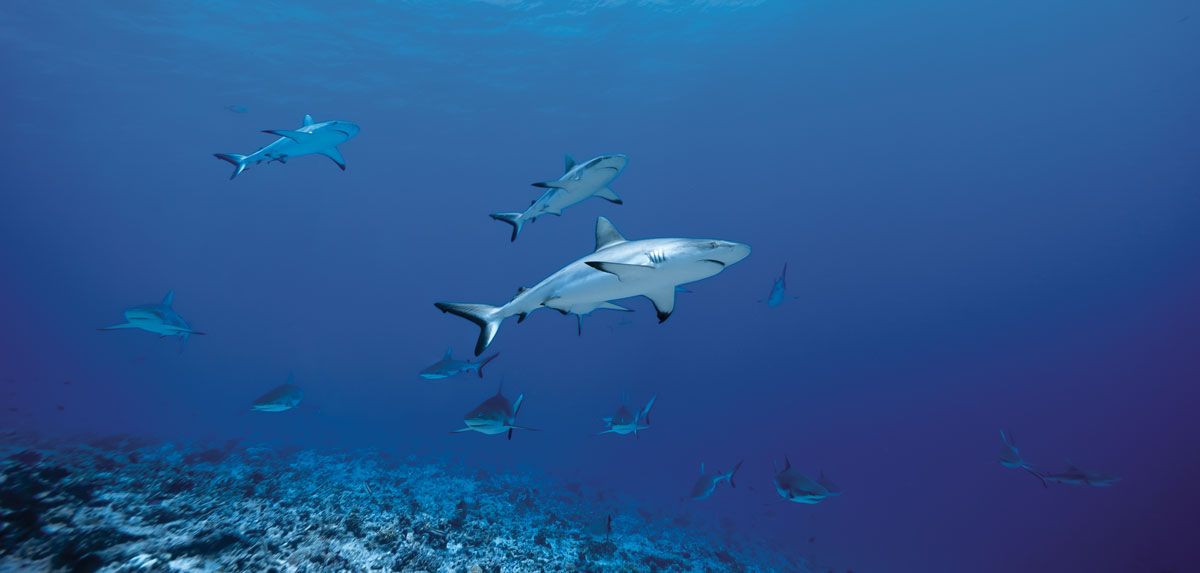
This Article From Issue
January-February 2025
Volume 113, Number 1
Page 56
THE SECRET HISTORY OF SHARKS: The Rise of the Ocean’s Most Fearsome Predators. John Long. 480 pp. Ballantine Books, 2024. $35.00.
For anyone fascinated by the mysteries hidden beneath the ocean waves and the ancient creatures that once roamed our oceans, John Long’s The Secret History of Sharks: The Rise of the Ocean’s Most Fearsome Predators offers an exhilarating journey through time. Long brings to life the incredible story of sharks: predators that have not only survived but thrived for millions of years.
Long, a world-renowned paleontologist, writes, “The origin of sharks is one of the last great unsolved mysteries in the five-hundred-million-year-old evolution of the backboned animals we call ‘vertebrates’ (fish, amphibians, birds, reptiles, and mammals).” He goes on to meticulously trace the evolutionary journey of these incredible creatures, guiding the reader through millions of years with a narrative that is scientifically rigorous, introducing us to the earliest protosharks and eventually to the formidable predators we know (and love or fear) today.
While the Megalodon is a natural climax to the shark’s history, some of the most intriguing parts of this book were the detailed portrayals of various lesser-known sharks and their evolutionary branches. Long describes astonishing creatures like collared catsharks, who have the “amazing ability to change their body color to match the seabed to blend in, to hide from predators or ambush prey” or the extinct genus Ptychodus, whose “jaws were lined with hundreds of mostly wrinkly, dome-shaped crushing teeth.” When describing various types of sharks that have long since gone extinct, there are clear distinctions between what are established facts, informed speculation, and Long’s narrative license. This transparency is a departure from some other popular science books, where the lines between fact and the author’s speculation are often blurred.

Jonas Gruhlke
Long presents recent, cutting-edge science made possible by recent technological advancements, which makes the book feel current while simultaneously underscoring the dynamic nature of paleontological research. He discusses how these technologies have allowed scientists to reassess existing fossil collections, leading to new discoveries and interpretations. For example, through techniques such as computed tomography (CT) scans and advanced imaging, scientists have captured fine details that have previously eluded them, allowing them to create more precise digital models, which have facilitated detailed analyses and comparisons with today’s shark species. This has led to the identification of new species and a deeper understanding of the evolutionary pathways that resulted in the diversity of sharks we see today.
Interspersed throughout the book are biographical sketches of scientific figures in shark science, including anecdotes that bring important people in the field to life and provide quirky and interesting details about them to the reader. For example, Chas Eastman, who “expanded our knowledge of buzz saw sharks, the Solnhofen sharks from Germany, the great Cretaceous lamniforms, the complete Eocene sharks and fishes of Bolca, Italy, and Cenozoic sharks from several U.S. and other localities around the world,” was indicted for the murder of his brother-in-law, did significant paleontological research while behind bars waiting for trial, and ended up winning the case and was released. Reading details often left out of textbooks and memoirs of these scientific giants is refreshing, especially during a time when scientists are being asked to take a close look at their predecessors’ prejudicial viewpoints. Long’s recounting of his own experiences and relationships in the research community adds another layer of intimacy. While some might perceive this as boasting, it can also be seen as justifiable pride in his contributions and appreciation of his connections in the field.
Along with photographs and diagrams that complement the text, readers will find themselves immersed in the life of a paleontologist, sharing Long’s experiences on global expeditions, from the fossil-rich beds of North America to surviving emus in Australia to the remote cliffs of Antarctica. Each adventure is pulse-pounding, giving readers a front row seat to the discoveries that have reshaped our understanding of shark evolution.
Parts of the book are much denser than others, due to the technical depth of the research and writing. The section on the Cretaceous period, for instance, is densely packed with biological and biographical information; all of that is fascinating, but can feel overwhelming if the reader does not have a background in paleontology. However, the book largely succeeds, thanks to Long’s ability to translate complex scientific findings into understandable language. This is complemented by a thorough index, which is particularly helpful for those looking to delve deeper into specific topics. He peppers the text with unexpected language that helps make scientific literature entertaining, like “how placoderms made sharks sexy” and “sharky-sharks.” With an engaging writing style, his ability to weave personal anecdotes and experiences into the broader narrative highlights his enthusiasm for the subject matter. This enthusiasm is infectious, making The Secret History of Sharks a page-turner even for less shark-obsessed readers.
This book is not just a recount of the past; it is a poignant reminder of the current threats these survivors face. Long brings attention to the numerous urgent threats facing sharks today, from overfishing and habitat destruction to the wide-reaching effects of climate change. He passionately argues for sharks’ conservation, highlighting that the survival of sharks is intricately tied to the health of our oceans and the balance of marine ecosystems, and reminding us that saving these apex predators isn’t just about protecting one species—it’s about safeguarding our planet’s most vital ecosystem. But Long doesn’t stop at sharks’ ecological importance; he explores the surprising ways they contribute to human advancement. From the potential antibiotic applications of their unique immune systems to the breakthroughs in medical research their study has enabled, sharks are providing novel insights into fields far beyond marine biology.
The Secret History of Sharks offers more than just a journey through millions of years of shark evolution; it is a call to action for a deeper appreciation and preservation of these extraordinary predators. By showcasing their adaptability, resilience, and even their unlikely contributions to human innovation, Long underscores that sharks are not just relics of the past but invaluable allies in our planet’s future. This accessible and engaging book is not only an enlightening read for those curious about marine life, but also a compelling case for why their survival is essential to our own.

American Scientist Comments and Discussion
To discuss our articles or comment on them, please share them and tag American Scientist on social media platforms. Here are links to our profiles on Twitter, Facebook, and LinkedIn.
If we re-share your post, we will moderate comments/discussion following our comments policy.